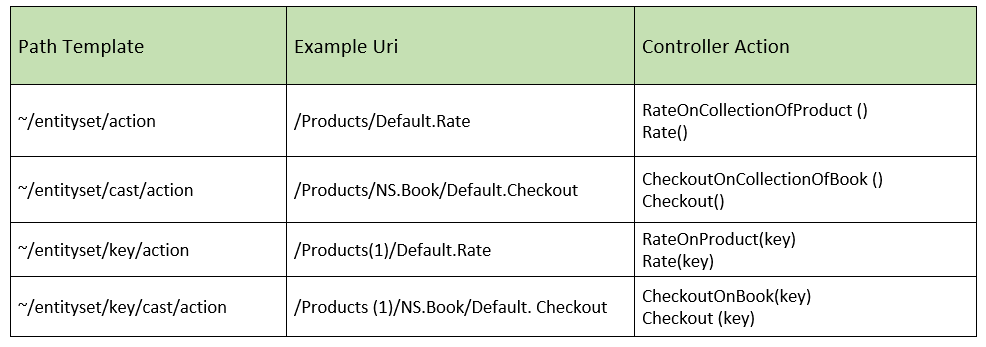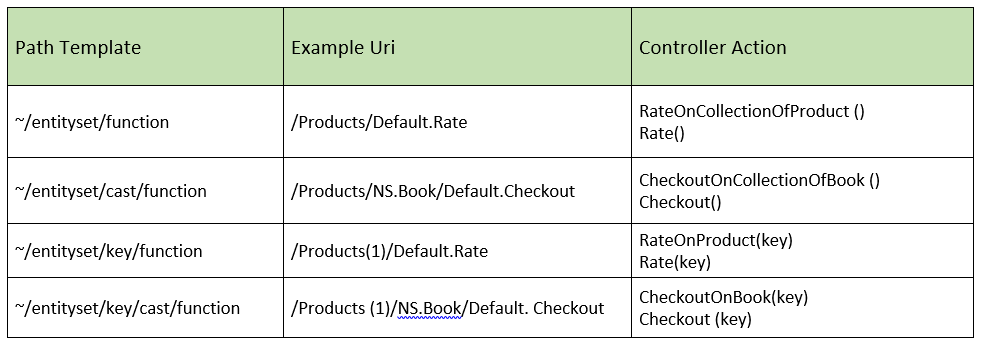3.2 Built-in routing conventions
When Web API gets an OData request, it maps the request to a controller name and an action name. The mapping is based on the HTTP method and the URI. For example, GET /odata/Products(1) maps to ProductsController.GetProduct.
This article describe the built-in OData routing conventions. These conventions are designed specifically for OData endpoints, and they replace the default Web API routing system. (The replacement happens when you call MapODataRoute.)
Built-in Routing Conventions
Before describe the OData routing conventions in Web API, it’s helpful to understand OData URIs. An OData URI consists of:
- The service root
- The odata path
- Query options
For example: http://example.com/odata/Products(1)/Supplier?$top=2
- The service root : http://example.com/odata
- The odata path : Products(1)/Supplier
- Query options : ?$top=2
For OData routing, the important part is the OData path. The OData path is divided into segments, each segments are seperated with ‘/’.
[For example], Products(1)/Supplier has three segments:
- Products refers to an entity set named “Products”.
- 1 is an entity key, selecting a single entity from the set.
- Supplier is a navigation property that selects a related entity.
So this path picks out the supplier of product 1.
OData path segments do not always correspond to URI segments. For example, “1” is considered a key path segment.
Controller Names. The controller name is always derived from the entity set at the root of the OData path. For example, if the OData path is Products(1)/Supplier, Web API looks for a controller named ProductsController.
So, the controller convention is: [entityset name] + “Controller”, derived from ODataController
Action Names. Action names are derived from the path segments plus the entity data model (EDM), as listed in the following tables. In some cases, you have two choices for the action name. For example, “Get” or “GetProducts”.
Querying Entities

Creating, Updating, and Deleting Entities

Operation on Navigation Property

Querying, Creating and Deleting Links

Properties
| Request | Example URI | Action Name | Example Action |
|---|---|---|---|
| GET /entityset(key)/property | /Products(1)/Name | GetPropertyFromEntityType or GetProperty | GetNameFromProduct |
| GET /entityset(key)/cast/property | /Products(1)/Models.Book/Author | GetPropertyFromEntityType or GetProperty | GetTitleFromBook |
Actions
Action only supports the POST request method, and the parameters are sent using the request body. In controller, each action is using an ODataActionParameters to accept the parameters’ value:

Functions
Functions only supports the GET request method.

Method Signatures
Here are some rules for the method signatures:
- If the path contains a key, the action should have a parameter named key.
- If the path contains a key into a navigation property, the action should have a parameter named relatedKey.
- POST and PUT requests take a parameter of the entity type.
- PATCH requests take a parameter of type Delta, where T is the entity type.
For reference, here is an example that shows method signatures for most built-in OData routing convention.
public class ProductsController : ODataController
{
// GET /odata/Products
public IQueryable<Product> Get()
// GET /odata/Products(1)
public Product Get(int key)
// GET /odata/Products(1)/ODataRouting.Models.Book
public Book GetBook(int key)
// POST /odata/Products
public HttpResponseMessage Post(Product item)
// PUT /odata/Products(1)
public HttpResponseMessage Put(int key, Product item)
// PATCH /odata/Products(1)
public HttpResponseMessage Patch(int key, Delta<Product> item)
// DELETE /odata/Products(1)
public HttpResponseMessage Delete(int key)
// PUT /odata/Products(1)/ODataRouting.Models.Book
public HttpResponseMessage PutBook(int key, Book item)
// PATCH /odata/Products(1)/ODataRouting.Models.Book
public HttpResponseMessage PatchBook(int key, Delta<Book> item)
// DELETE /odata/Products(1)/ODataRouting.Models.Book
public HttpResponseMessage DeleteBook(int key)
// GET /odata/Products(1)/Supplier
public Supplier GetSupplierFromProduct(int key)
// GET /odata/Products(1)/ODataRouting.Models.Book/Author
public Author GetAuthorFromBook(int key)
// POST /odata/Products(1)/Supplier/$ref
public HttpResponseMessage CreateLink(int key,
string navigationProperty, [FromBody] Uri link)
// DELETE /odata/Products(1)/Supplier/$ref
public HttpResponseMessage DeleteLink(int key,
string navigationProperty, [FromBody] Uri link)
// DELETE /odata/Products(1)/Parts(1)/$ref
public HttpResponseMessage DeleteLink(int key, string relatedKey, string navigationProperty)
// GET odata/Products(1)/Name
// GET odata/Products(1)/Name/$value
public HttpResponseMessage GetNameFromProduct(int key)
// GET /odata/Products(1)/ODataRouting.Models.Book/Title
// GET /odata/Products(1)/ODataRouting.Models.Book/Title/$value
public HttpResponseMessage GetTitleFromBook(int key)
}
Update form Routing Conventions in OData V3.0